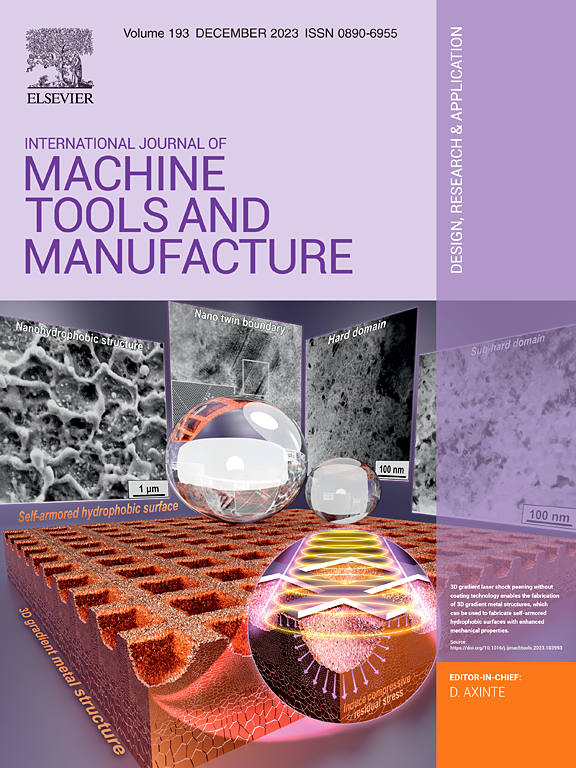Novel multi-axis differential velocity sideways extrusion process for 3D curved profiles: Feasibility and forming mechanisms studies
IF 18.8
1区 工程技术
Q1 ENGINEERING, MANUFACTURING
International Journal of Machine Tools & Manufacture
Pub Date : 2025-06-12
DOI:10.1016/j.ijmachtools.2025.104306
引用次数: 0
Abstract
3D curved profiles or extrudates are widely used in industry; however, their flexible manufacturing with very few processing steps remains a great challenge. In this study, a novel extrusion-bending integrated process, termed multi-axis differential velocity sideways extrusion (MX-DVSE), was developed to form controlled 3D curved extrudates within a single operation, and its forming mechanics was clarified by experiments and finite element modelling. The MX-DVSE equipment was set up, and a set of dies was designed to perform a series of experiments in which two pairs of opposing punches were moved at different velocities. During the MX-DVSE process, the superposition of the velocity gradients generated by the four extrusion velocities induces the bending deformation of the extrudates with a controllable bending radius and deflection angle. The bending radius is determined by velocity gradient, velocity gradient ratio, and extrusion ratio. The bending radius decreased with an increase in the deviation of the velocity gradients from 1, reduction in the velocity gradient ratio, and increase in the extrusion ratio. The velocity gradient and velocity gradient ratio can be unified into a proposed indicator, termed the bending radius control factor, which exhibits a monotonic relationship with the bending radius. The deflection angle depends on the extrusion velocity and the velocity gradient. The bending plane of the extrudate was close to the direction of the velocity gradient, which deviated from 1 or the direction of the maximum velocity. This is reflected in another proposed indicator: the deflection angle control factor. The feasibility of the MX-DVSE technique was further verified by considering the specific shape and size of 3D curved extrudates as the forming targets. The experimental results show that MX-DVSE can form 3D curved extrudates with acceptable dimensional accuracy, and the proposed control factors for the bending radius and deflection angle can accurately control the shape of the 3D curved extrudates. Moreover, compared to forward extrusion, MX-DVSE was more effective in refining grains and enhancing the strength and ductility of extrudates with the same extrusion parameters. This study demonstrates that MX-DVSE has great potential for the development and application of flexible manufacturing of 3D curved extrudates.

三维弯曲型材的新型多轴差速侧向挤压工艺:可行性及成形机理研究
三维曲面型材或挤出物在工业中应用广泛;然而,它们的柔性制造和很少的加工步骤仍然是一个巨大的挑战。在这项研究中,开发了一种新的挤压弯曲集成工艺,称为多轴差速侧向挤压(MX-DVSE),可以在一次操作中形成受控的3D弯曲挤出物,并通过实验和有限元建模阐明了其成形机理。建立了MX-DVSE设备,设计了一套模具,进行了一系列实验,其中两对相反的冲头以不同的速度移动。在MX-DVSE过程中,四种挤出速度产生的速度梯度叠加,使挤出物发生弯曲变形,弯曲半径和偏转角可控。弯曲半径由速度梯度、速度梯度比和挤压比决定。弯曲半径随速度梯度与1的偏差增大、速度梯度比减小、挤压比增大而减小。速度梯度和速度梯度比可以统一为一个指标,称为弯曲半径控制因子,它与弯曲半径呈单调关系。偏转角度取决于挤压速度和速度梯度。挤出物弯曲面接近速度梯度方向,偏离最大速度方向1。这反映在另一个拟议的指标:偏转角控制系数。以三维弯曲挤出物的特定形状和尺寸为成形目标,进一步验证了MX-DVSE技术的可行性。实验结果表明,MX-DVSE能够以可接受的尺寸精度形成三维弯曲挤出物,所提出的弯曲半径和挠度控制因子能够精确控制三维弯曲挤出物的形状。此外,与正挤压相比,在相同挤压参数下,MX-DVSE能更有效地细化晶粒,提高挤压物的强度和塑性。该研究表明,MX-DVSE在三维弯曲挤出物的柔性制造中具有很大的开发和应用潜力。
本文章由计算机程序翻译,如有差异,请以英文原文为准。
求助全文
约1分钟内获得全文
求助全文
来源期刊
CiteScore
25.70
自引率
10.00%
发文量
66
审稿时长
18 days
期刊介绍:
The International Journal of Machine Tools and Manufacture is dedicated to advancing scientific comprehension of the fundamental mechanics involved in processes and machines utilized in the manufacturing of engineering components. While the primary focus is on metals, the journal also explores applications in composites, ceramics, and other structural or functional materials. The coverage includes a diverse range of topics:
- Essential mechanics of processes involving material removal, accretion, and deformation, encompassing solid, semi-solid, or particulate forms.
- Significant scientific advancements in existing or new processes and machines.
- In-depth characterization of workpiece materials (structure/surfaces) through advanced techniques (e.g., SEM, EDS, TEM, EBSD, AES, Raman spectroscopy) to unveil new phenomenological aspects governing manufacturing processes.
- Tool design, utilization, and comprehensive studies of failure mechanisms.
- Innovative concepts of machine tools, fixtures, and tool holders supported by modeling and demonstrations relevant to manufacturing processes within the journal's scope.
- Novel scientific contributions exploring interactions between the machine tool, control system, software design, and processes.
- Studies elucidating specific mechanisms governing niche processes (e.g., ultra-high precision, nano/atomic level manufacturing with either mechanical or non-mechanical "tools").
- Innovative approaches, underpinned by thorough scientific analysis, addressing emerging or breakthrough processes (e.g., bio-inspired manufacturing) and/or applications (e.g., ultra-high precision optics).

 求助内容:
求助内容: 应助结果提醒方式:
应助结果提醒方式:


